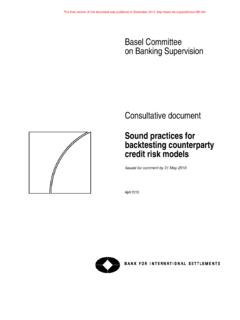Transcription of Central bank digital currencies - bis.org
1 Committee on Payments and Market infrastructures Markets Committee Central bank digital currencies March 2018 This publication is available on the BIS website ( ). Bank for International Settlements 2018. All rights reserved. Brief excerpts may be reproduced or translated provided the source is stated. ISBN 978-92-9259-142-7 (print) ISBN 978-92-9259-143-4 (online) Central bank digital currencies iii Foreword The history of Central banking began with payment services. Since then payment-related innovation has always been an integral part of Central banking. Modern examples include the establishment of systems allowing for immediate interbank gross settlement and the recent increased emphasis on faster retail payment systems.
2 Central bank digital currencies (CBDCs) represent another such potential innovation. This joint report by the Committee on Payments and Market infrastructures and the Markets Committee provides an initial analysis of CBDCs. It offers a high-level overview of their implications for payments, monetary policy and financial stability. The analysis of the committees reflects initial thinking in this rapidly evolving area and is a starting point for further discussion and research. It also highlights that the issuance of a CBDC requires careful consideration. The Committees thank Klaus L ber (European Central Bank) and Aerdt Houben (Netherlands Bank) and the two Committee working groups for their efforts in preparing this report.
3 Beno t C ur Jacqueline Loh Chair, Committee on Payments and Market infrastructures Chair, Markets Committee Central bank digital currencies v Contents Foreword ..iii Executive summary .. 1 1. Introduction .. 3 2. 3 The money flower .. 4 Design features .. 5 3. Payment 7 General purpose CBDC .. 7 Wholesale only CBDC .. 8 Other considerations .. 9 Key feasibility and operational challenges .. 9 4. Monetary policy aspects .. 10 Desirability for monetary policy .. 10 Implications for monetary policy implementation and interest rates .. 12 5. Financial intermediation, financial stability and cross-border aspects .. 14 Role of the Central bank.
4 14 Banks business models, financial intermediation and markets .. 15 Financial stability .. 16 Cross-border and global dimensions .. 17 References .. 19 Annex A: Principles of monetary policy implementation .. 21 Annex B: Flow-of-funds representation .. 24 Annex C: The impact of CBDC on seigniorage .. 26 Annex D: Members of the working groups .. 27 Committee on Payments and Market infrastructures .. 27 Markets Committee .. 28 Central bank digital currencies 1 Executive summary Interest in Central bank digital currencies (CBDCs) has risen in recent years. The Committee on Payments and Market infrastructures and the Markets Committee recently completed work on CBDCs, analysing their potential implications for payment systems, monetary policy implementation and transmission as well as for the structure and stability of the financial system.
5 Key highlights of the work are: CBDC is potentially a new form of digital Central bank money that can be distinguished from reserves or settlement balances held by commercial banks at Central banks. There are various design choices for a CBDC, including: access (widely vs restricted); degree of anonymity (ranging from complete to none); operational availability (ranging from current opening hours to 24 hours a day and seven days a week); and interest bearing characteristics (yes or no). Many forms of CBDC are possible, with different implications for payment systems, monetary policy transmission as well as the structure and stability of the financial system.
6 Two main CBDC variants are analysed in this report: a wholesale and a general purpose one. The wholesale variant would limit access to a predefined group of users, while the general purpose one would be widely accessible. CBDC raises old questions about the role of Central bank money, the scope of direct access to Central bank liabilities and the structure of financial intermediation. Traditionally, Central banks have, for various reasons, tended to limit access to ( digital ) account-based forms of Central bank money to banks and, in some instances, to certain other financial or public institutions. By contrast, physical Central bank money, ie cash, is widely accessible.
7 This approach has, in general, served the public and the financial system well, setting a high bar for changing the current monetary and financial structure. Wholesale CBDCs, combined with the use of distributed ledger technology, may enhance settlement efficiency for transactions involving securities and derivatives. Currently proposed implementations for wholesale payments designed to comply with existing Central bank system requirements relating to capacity, efficiency and robustness look broadly similar to, and not clearly superior to, existing infrastructures . While future proofs of concept may rely on different system designs, more experimentation and experience would be required before Central banks can usefully and safely implement new technologies supporting a wholesale CBDC variant.
8 In part because cash is rapidly disappearing in their jurisdiction, some Central banks are analysing a CBDC that could be made widely available to the general public and serve as an alternative safe, robust and convenient payment instrument. In circumstances where the traditional approach to the provision of Central bank money in physical form to the general public and in digital form to banks was altered by the disappearance of cash, the provision of CBDC could bring substantial benefits. However, analysing whether these goals could also be achieved by other means is advisable, as CBDCs raise important questions and challenges that would need to be addressed.
9 Most importantly, while situations differ, the benefits of a widely accessible CBDC may be limited if fast (even instant) and efficient private retail payment products are already in place or in development. Although a general purpose CBDC might be an alternative to cash in some situations, a Central bank introducing such a CBDC would have to ensure the fulfilment of anti-money laundering and counter terrorism financing (AML/CFT) requirements, as well as satisfy the public policy requirements of other supervisory and tax regimes. Furthermore, in some jurisdictions Central banks may lack the legal authority to issue a CBDC, and ensuring the robust design and operation of such a system could prove to be challenging.
10 An anonymous general purpose CBDC would raise further concerns and challenges. Although it is unlikely that such a CBDC would be considered, it would not necessarily be limited to retail payments and it could become widely used globally, including for illegal transactions. That said, compared with the current situation, a non-anonymous CBDC could allow for digital records and traces, which could improve the application of rules aimed at AML/CFT. 2 Central bank digital currencies Issuance of a CBDC would probably not alter the basic mechanics of monetary policy implementation, including Central banks use of open market operations.
















